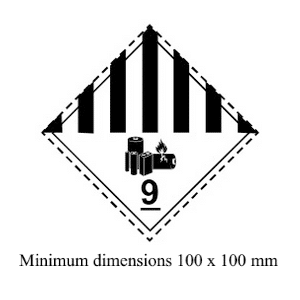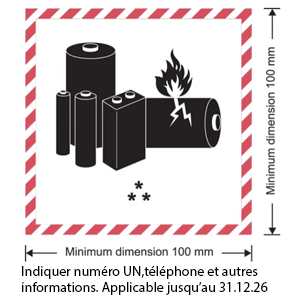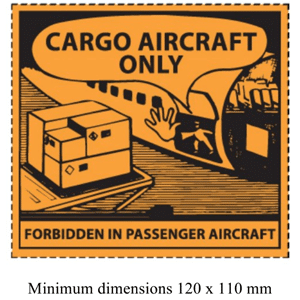General requirements
[/mvc_infobox]
Test requirements Test and Criteria Manual Each cell or battery is of the type proven to meet the requirements of each test in the Test and Criteria Manual, Part 3, sub-section 38.3. Batteries must be of a type proven to meet the test requirements of the Manual of Tests and Criteria, Part III, sub-section 38.3, whether or not the cells in them are of a proven type. With the exception of button cells installed in equipment (including printed circuit boards), manufacturers and subsequent distributors of cells or batteries manufactured after June 30, 2003 must make available the test summary as specified in the Manual of Tests and Criteria, Part III, subsection 38.3, paragraph 38.3.5. Due to copyright restrictions, this manual cannot contain the text of the Test and Criteria Manual, however, as a user, you can consult it on the following website: https://unece.org/transport/dangerous-goods/rev7-files
Depending on the production period, cells and batteries may be transported according to the following deadlines: MARC 2021 & 2023 Lithium cells and batteries manufactured to a type meeting the requirements of sub-section 38.3 of the Manual of Tests and Criteria, revision 3, amendment 1 or any subsequent revision and amendment applicable at the date of the type test may continue to be performed, unless otherwise specified in the ADR. Lithium cells and batteries manufactured before July 1, 2003 and complying with the requirements of the Manual of Tests and Criteria, Revision 3, may continue to be transported if all other applicable requirements are met. IMDG 40-20 & 41-22 IATA 2023
Each cell or battery is of the type proven to meet the requirements of each test in the UN Manual of Tests and Criteria, Part III, sub-section 38.3. Cells and batteries manufactured to a type meeting the requirements of sub-section 38.3 of the UN Manual of Tests and Criteria, Revision 3, Amendment 1 or any subsequent revision and amendment applicable at the date of type testing may continue to be transported, unless otherwise specified. provided for in the present regulations. Cells and batteries that only meet the requirements of the UN Manual of Tests and Criteria, Revision 3, are no longer valid. However, cells and batteries manufactured to these types before July 1, 2003 may continue to be transported if all other applicable requirements are met.
Damage Assembly Battery and short-circuit protection
[/mvc_infobox]
Short-circuit protection Cells and ballcrics must be prutcclcd to prevent short circuits. This includes protection against contact with conductive materials in the same packaging, which could result in a short circuit. Examples of short-circuit protection include, but are not limited to : – individual protection of battery terminals. – inner packaging to prevent contact between cells and batteries, – batteries with recessed lugs designed to protect against short-circuits, or – the use of an electrically non-conductive, non-combustible cushioning material to fill the empty space between cells or batteries in the packaging. Damaged and defective batteries Damaged lithium bullets mean in particular, but without limitation: – Cells or batteries identified as defective for safety reasons; – Cells or batteries that have leaked or stale; – Cells or batteries that cannot be diagnosed prior to transport; or – Cells or batteries that have suffered physical or mechanical damage.
When assessing a cell or battery as damaged or defective, an assessment must be made on the basis of the cell, battery or product manufacturer’s safety criteria, or by a technical expert familiar with the safety features of the cell or battery. An assessment or evaluation may include, but is not limited to, the following criteria: [a] Acute danger, such as gas, fire or electrolyte leakage; [b] Use or misuse of the cell or battery; [c] Signs of physical damage. such as deformation of the cell or battery casing, or colors on the casing [d] External and internal short-circuit protection, such as voltage or insulation measurements; [e] The state of the safety features of the cell or battery; or [I] Damage to any internal safety components, such as the battery management system. The transport of damaged and defective batteries is regulated as follows: ADR 2[l2l & 2023 IMDG 40-2|] Kt 41-22
Non-critical” cells and batteries (not likely to react dangerously during transport) : Permitted under special provision 376 and packing instructions P908 and LP904 “Critical” cells and batteries [susceptibles de réagir dangereusement pendant le transport] Permitted under Special Provision 3’16 and Packing Instructions P91 1 and LP906 IATA 20222 Prohibits “critical” and “non-critical” cells and batteries from air transport. Non-critical” batteries: NOT likely to react negatively during sport. Packaging procedures require approved packaging of the performance level of packaging group ll. Packages must be marked “DAMAGED LITHIUM-ION BATTERIES” or “DAMAGED LITHIUM METAL BATTERIES”, as appropriate. Cells or batteries shall be protected against short circuit.
Transport
[/mvc_infobox]
Each damaged or defective cell or battery or any equipment containing such cells or batteries must: be individually packed in an inner packaging and placed inside an outer packaging. Cells or batteries with a net mass exceeding 30 kg must be limited to one cell or battery per outer packaging. Each inner pack must be surrounded by a sufficient number of non-combustible and electrically non-combustible outer packs. Thermally conductive insulation material to protect against dangerous heat evolution. Non-combustibility must be assessed in accordance with a standard recognized in the country where the packaging is designed or manufactured. Appropriate measures must be taken to minimize the effects of vibration and shock, and to prevent movement of cells or batteries inside the packaging, which may lead to further damage and hazardous conditions during transport. Non-combustible cushioning material and non-conductive electrical products can also be used to meet this requirement. The inner or outer packaging must be leak-proof to prevent the potential release of electrolyte. For leaking cells or batteries, sufficient inert absorbent material must be added to the inner or outer packaging to absorb any electrolyte release. Batteries and cells RESPONSIBLE” F0 DANGEROUS REACTIONS during transport Batteries and cells liable to dismantle rapidly, to react dangerously, to produce a flame or a dangerous release of heat, or to emit toxic, corrosive or flammable gases or vapors under normal conditions of transport. They may be transported in accordance with packing instructions P91 1 and LP906. Packing procedures require approved packaging of packing group l to perform and be capable of meeting the following additional performance requirements: a- The outer surface temperature of the complete package must not exceed 100° with a momentary peak temperature of up to 200°C acceptable; b- No flames must occur outside the package; c- No projectiles must exit the package; d- The structural integrity of the package must be maintained; and e- Packages must be equipped with a gas management system (e.g. filtration system, air circulation, gas containment, gas-tight packagings, etc., as appropriate.), as appropriate.
In the ADR, batteries are assigned to transport category CI. Packages must be marked “DAMAGED/DEFECTIVE LlTH[UM—[ClN BATTERIES] ” or “LITHIUM METAL BATTERlES ENDOMMAGÉ/DÉFECTUEUX”, as appropriate. Cells or batteries shall be protected against short circuit. Other conditions of packing and carriage may be authorized by the authority of any ADR Contracting Party. 1.3.5 Packages containing a combination of lithium batteries “packed with” and “contained in equipment” ADR 2021 Ba 2023 IMDG 40-20 &4l -22 SP39 – When a package contains a combination of lithium batteries contained in equipment and lithium batteries packed with equipment, the following requirements apply for marking and documentation purposes: [a] the package must be marked “UN 3091” or “UN 3481”, as appropriate. If a package contains both lithium-ion and lithium-metal batteries packaged with and contained in equipment, the package must be marked as required for both types of battery. However, the button cells installed in the equipment [y compris les cartes de circuits imprimés] need not be taken into consideration; [b] the transport document must be marked “UN 3091 LlTl-HUM METAL ” BATTERIES EMBALLÉES AVEC UN ÉQUIPEMENT” or “UN 34-81 LITHIUM L0N BATTERIES EMBALLÉES AVEC UN ÉQUIPEMENT”, as appropriate. If a package contains both lithium metal batteries and lithium ion batteries packed with and contained in equipment, the transport document must indicate both “UN 3091 LlTHlUM METAL BATTERIES PACKED WITH EQUIPMENT” and “UN 3481 LITHIUM ION BATTERIES PACKED WITH EQUIPMENT”. IATA 2023 A181 – The air transport regulations clarify the requirements for this combination of lithium batteries packed with equipment and li|’ 11ium batteries contained in equipment in the same package :
– the package must be marked UN 3091 Lithium metal batteries packed with equipment, or UN 3481 Lithium ion batteries packed with equipment, as appropriate. – all applicable parts of both packing instructions must be observed. – button cells installed in [y compris les cartes de circuits imprimés] equipment need not be considered. – the total weight of lithium batteries contained in a package must not exceed the limits for passenger aircraft or freight aircraft, as applicable. – the shipper’s declaration must indicate UN 3091 Lithium metal batteries packed with or UN 3481 Lithium ion batteries packed with equipment, as appropriate. – if a package contains lithium ion bot.h batteries and lithium metal batteries packed with and contained in equipment, the package must bear the required marking for both batteries and the dangerous goods transport document must show both UN 3091 Lithium metal batteries packed with equipment and UN 34431 Lithium ion batteries packed with equipment. Lithium batteries containing both a combination of primary lithium metal cells and rechargeable lithium ion cells according to special provision 387, lithium batteries containing both primary lithium metal cells and rechargeable lithium ion cells must be assigned to UN 3090 or 3091, as appropriate. When these batteries are transported in accordance with special provision 1B8, the total lithium content of all the lithium metal cells contained in the battery must not exceed 1.5 g and the total capacity of all the lithium ion cells contained in the battery must not exceed 10 Wh.
Each damaged or defective cell or battery or any equipment containing such cells or batteries must: be individually packed in an inner packaging and placed inside an outer packaging. Cells or batteries with a net mass exceeding 30 kg must be limited to one cell or battery per outer packaging. Each inner pack must be surrounded by a sufficient number of non-combustible and electrically non-combustible outer packs. Thermally conductive insulation material to protect against dangerous heat evolution. Non-combustibility must be assessed in accordance with a standard recognized in the country where the packaging is designed or manufactured. Appropriate measures must be taken to minimize the effects of vibration and shock, and to prevent movement of cells or batteries inside the packaging, which may lead to further damage and hazardous conditions during transport. Non-combustible cushioning material and non-conductive electrical products can also be used to meet this requirement. The inner or outer packaging must be leak-proof to prevent the potential release of electrolyte. For leaking cells or batteries, sufficient inert absorbent material must be added to the inner or outer packaging to absorb any electrolyte release. Batteries and cells RESPONSIBLE” F0 DANGEROUS REACTIONS during transport Batteries and cells liable to dismantle rapidly, to react dangerously, to produce a flame or a dangerous release of heat, or to emit toxic, corrosive or flammable gases or vapors under normal conditions of transport. They may be transported in accordance with packing instructions P91 1 and LP906. Packing procedures require approved packaging of packing group l to perform and be capable of meeting the following additional performance requirements: a- The outer surface temperature of the complete package must not exceed 100° with a momentary peak temperature of up to 200°C acceptable; b- No flames must occur outside the package; c- No projectiles must exit the package; d- The structural integrity of the package must be maintained; and e- Packages must be equipped with a gas management system (e.g. filtration system, air circulation, gas containment, gas-tight packagings, etc., as appropriate.), as appropriate.
Packaging Dangerous goods must be packed in good quality packaging. Packaging must be strong enough to withstand the shocks and loads normally encountered during transport, including transhipment between transport units and between transport units and warehouses. Packagings must be constructed and closed in such a way as to prevent any loss of contents during preparation for transport which might be caused under normal conditions of transport, by vibration or by changes in temperature, humidity or pressure. No dangerous residues may adhere to the outside of packagings during transport. “Overpack” means an enclosure used (by a single shipper in the case of Class 7) to contain one or more packages, grouped together in a single unit that is easier to handle and store during transport; Example overpacking
- A loading platform such as a pallet, on which several packages are placed or stacked and secured by a plastic strip, a shrink or stretch wrapping or any other suitable means, or an outer protective wrapping such as a box or crate;
“Packaging” means the complete product of the packaging operation, consisting of the packaging and its contents prepared for shipment. Dangerous goods must not be packed together in the same outer packaging or in large packagings with dangerous goods or other goods if they react dangerously with each other and cause: [a] combustion or release of considerable heat; [h] release of inflammable, asphyxiating, oxidizing or toxic gases; [c] formation of corrosive substances; or [d] formation of unstable Substances. Before being filled and released for transport, all packagings, including IBCs and large packagings, must be checked for corrosion, contamination or other defects. Any packaging showing signs of embrittlement compared with the approved prototype must not be used again, or must be refurbished so that it can pass the matrix tests required for the plastic packaging prototype. For plastic drums and jerrycans, rigid plastic IBCs and composite IBCs with plastic interior containers, unless otherwise approved by the competent authority, the duration of use for the arrival of hazardous substances is five years from the date of manufacture of the container, except where use is prescribed for a shorter term due to the nature of the material taken. The packs must have passed specific tests and conform to the prototype tested. Packaging must be manufactured, reconditioned and tested under a quality assurance program that satisfies the competent authority.
Packaging
[/mvc_infobox]
Non-approved packaging
When packagings which do not have to meet the requirements of 4.1.1.3 (e.g. crates, pallets) are authorized in a packing instruction or special provision, they are not subject to the mass or volume limits generally applicable to packagings (400 kg or 450 L) complying with the requirements of Chapter 6.1, unless otherwise specified in the relevant packing instruction or special provision.
| Type | Matière | Categorie | Code |
|---|---|---|---|
| Batterie | A. Acier | Ouverture par le haut | 1A2 |
| B. Aluminium | Ouverture par le haut | 1B2 | |
| D, Contreplaqué | - | 1D | |
| G. Fibre | - | 1G | |
| H. Plastique | Ouverture par le haut | 1H2 | |
| N. metal, acier ou aluminium | Ouverture par le haut | 1N2 | |
| Jerricane | A, Acier | Ouverture par le haut | 3A2 |
| B. Aluminium | Ouverture par le haut | 3B2 | |
| H. Plastique | Ouverture par le haut | 3H2 | |
| Box | A. Acier | - | 4A |
| B. Aluminium | - | 4B | |
| C. Bois naturel | Ordinaire / avec parois étanches aux pulvérulents | 4C1 4C2 | |
| D. Contreplaqué | - | 4D | |
| F. Bois reconstitué | - | 4F | |
| G. Fibrebois | - | 4G | |
| H. Plastique | Etendue | 4H1 / 4H2 | |
| N, Métal, autre acier ou aluminium | - | 4N | |
A rectangle or square with minimum dimensions of 100 x 100 mm and minimum hatch width of 5 mm. The symbol should be black, the hatchings red. If the size of the package so requires, the dimensions can be reduced to no less than 100 x 70 in height. The 120 x 110 mm rectangular mark can continue to be used. For IATA DGR, UN numbers must be at least 12 mm high. Documentation All shipments of regulated dangerous goods must be accompanied by the documentation prescribed in this chapter. UN No. / Proper shipping name / Label designator (class)/ Packing group () The description of the dangerous goods must be made in the following order: (example: UN No. 3090, LITHIUM METAL BATTERIES, 9) () Lithium batteries have not been assigned a packing group. – package number and description Other information required is as follows: – total quantity of each item of dangerous goods – name and address of consignor – name and address of consignee(s). Note: The proper shipping name is always “batteries”, whether “cells” or “batteries”. Specific documents are required by the different modes of transport, which are described below, underlining their own specificities that must be fulfilled by the shipper. The following pages show examples of compiled transport documents Road transport – ADR
- Tunnel restriction code
Additional information required: Maritime transport – IMDG Code
- Emergency response information, use in accident and emergency response
Additional information required: incidents involving dangerous goods in transit. Air transport – IATA DGR
- Prescribed limits for passenger and cargo aircraft
Additional information required:
- Radioactive materials

Packing group letter: X for packing groups I, ll and lll Y for packing groups II and III Z only for packing group III “Cylinder” a cylindrical packaging with a flat or convex base made of metal, cardboard, plastics, plywood or other suitable materials. This definition also includes packaging of other shapes, e.g. round conical-neck or bucket-shaped packaging. Wooden drums and canisters are not covered by this definition. “Jerrican” means a metal or plastic container with a rectangular or polygonal cross-section and one or more openings. “Box” means a packaging with complete rectangular or polygonal faces, made of metal, wood, plywood, reconstituted wood, fibreboard, plastic or other suitable material. Small holes for ease of handling or opening, or to meet classification requirements, are permitted as long as they do not compromise the integrity of the packaging during transport.
1.5 Marking and labelling The UN preceded by the letters “UN” must be clearly and durably affixed to each package. Size of mark: – The UN number and the letters “UN” must be at least 12 mm high – For packages with a capacity of 30 liters or less or a maximum net mass of 30 kg, they must be at least 6 mm high, except for packages of 5 liters or 5 kg or less, when they must be of an appropriate size. – For markings in the form of specific wording, the size of the characters must be at least 12 mm high: OVERWRING DAMAGED/ DEFECTED LITHIUM-ION BATTERIES or DAMAGED/ DEFECTED LITHIUM BATTERIES METAL BATTERIES LITHIUM BATTERIES FOR RECYCLING or LITHIUM BATTERIES FOR DISPOSAL Special item The marking must be affixed to the object, its cradle or to its handling, storage or launching device. The marking must be easily visible and legible, and must be able to withstand exposure to the elements without substantial reduction in electivity. The IMDG code requires an immersion test of at least three months in the sea. Label The labels must be in the square d placed at an angle of 45° (diamond-shaped) with minimum dimensions of 100 mm by 100 mm, except in the case of packages of such dimensions that they may only bear smaller labels; this exception does not apply to air transport. They must have a line 5 mm inside the edge and parallel to it. Labels must be easily visible and legible, and must be able to withstand exposure to the elements without substantial reduction in effectiveness; the IMDG code requires a test of at least three months under water. Marks and labels used in this manual
| TRANSPORT DOCUMENT | |||||||||||||||
| Consignor | |||||||||||||||
| Company ____________________________________________________ | |||||||||||||||
| _____________________________________________________________ | |||||||||||||||
| _____________________________________________________________ | |||||||||||||||
| _____________________________________________________________ | |||||||||||||||
| Consignor | |||||||||||||||
| Company ____________________________________________________ | |||||||||||||||
| _____________________________________________________________ | |||||||||||||||
| _____________________________________________________________ | |||||||||||||||
| _____________________________________________________________ | |||||||||||||||
| Name and Description | |||||||||||||||
| UN 3090, LITHIUM METAL BATTERIES,9,(E) | |||||||||||||||
| No, Packages | 1 | ||||||||||||||
| Description of packages : | Fibreboard box | ||||||||||||||
| Total quantity of each item of dangerous good kg : | 15 | ||||||||||||||
Transport document
[/mvc_infobox]
The layout of this form is not mandatory, but the information requested is. The sender fills in the yellow sections of the document. Note: Do not fill in box n. 8.

Due to copyright restrictions on ADR, IMDG and IATA regulations, this manual cannot contain the text of the packaging instructions applicable to the various modes of transport, however, as the user
The sender fills in the yellow sections of the document;
In the bottom right-hand corner, the title of the person signing the declaration and the place of declaration are now optional and can be left blank.

Due to copyright restrictions, ADR, IMDG and IATA regulations, this manual cannot contain the text of the special provisions applicable to the various modes of transport, however, as a user.






